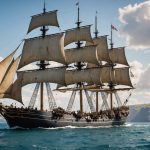Overview of British Maritime Exploration
The maritime history of Britain is rich and pivotal, marking significant advancements in global exploration. Illustrating this journey involves acknowledging key periods and renowned British explorers who shaped the world as we know it. Beginning in the 15th century, the Age of Discovery marked a transformative era in exploration.
Renowned figures such as John Cabot played a crucial role during this period. In 1497, Cabot made a significant contribution by discovering parts of North America, although there is debate over whether he reached Newfoundland or another part of modern-day Canada. This era continued into the 16th century with Sir Francis Drake, famed for his circumnavigation of the globe between 1577 and 1580, broadening the scope of British influence.
Also read : Top Birdwatching Hotspots to Explore in Norfolk Broads National Park
The exploration timeline extended into the 18th century with Captain James Cook, who embarked on his journeys through the Pacific Ocean. His extensive travels charted numerous islands and coastlines across Australia, New Zealand, and Hawaii, greatly enhancing Britain’s maritime discoveries.
These explorations had an enormous impact, not only in expanding British knowledge but also in developing lucrative trade routes and asserting British power on the world stage. The legacy of these explorations continues to inform Britain’s maritime prowess today.
Topic to read : Discover the Top Destinations for an Enriching Journey Through British Literary History in Stratford-upon-Avon
Top Destinations for British Maritime Exploration
Embark on a journey through time as you explore some of the most prominent destinations in British maritime exploration. From historic sites that shaped naval history to impressive maritime museums housing irreplaceable artifacts, there’s much to discover.
The Notable Maritime Museums
The National Maritime Museum in Greenwich stands as a beacon of Britain’s seafaring past. Here, visitors can witness a wide array of exhibits, from ancient navigational instruments to paintings of legendary sea battles, capturing the essence of exploration. Situated in Halifax, the Maritime Museum of the Atlantic sheds light on maritime tragedy and triumph, showcasing remnants from the Titanic while celebrating maritime innovation. Equally compelling, the National Museum of the Royal Navy in Portsmouth boasts unique exhibits like the historic warships HMS Victory and HMS Warrior, pivotal iconographies of British naval strength.
Significant Historical Ports
Bristol, once bustling with international trade, served as a birthplace for many transatlantic voyages that expanded Britain’s global reach. Meanwhile, Liverpool’s maritime legacy includes its pivotal role in the transatlantic slave trade and as a major port for emigrants. Similarly, Plymouth carries rich naval history, symbolized by the Mayflower Steps, marking where the Pilgrims set sail for America.
Maritime Exploration Landmarks
The Cutty Sark in London, a legendary 19th-century clipper ship, stands proud, offering insights into historic maritime trading routes. While Stonehenge might initially seem unrelated, its maritime connections link cultural and navigational advancements. Lastly, the Tower of London, beyond its imposing presence, has been a guardian of British naval power for centuries, witnessing countless maritime events.
Historical Context and Significance
The maritime legacy of Britain holds immense historical significance, as it has profoundly influenced both the society and culture over the centuries. British maritime exploration impact played a crucial role in establishing trade routes, fostering cultural exchanges, and expanding the Empire. It was through these exploratory ventures that Britain could dominate vast oceanic expanses, securing its position as a global power.
Influence on Society and Culture
British maritime exploration permeated various aspects of everyday life. The social history of the time was marked by the emergence of port cities as bustling hubs of trade and culture. These cities became melting pots of different cultures, languages, and ideas, enriching the nation’s social fabric.
Empire and Maritime Exploration
The close relationship between maritime exploration and the Empire shaped policies and strategies, ultimately leading to British dominance across continents. Seafaring endeavours were vital in acquiring colonies, accessing resources, and spreading influence globally.
Key Maritime Events
Notable events in maritime history, such as the defeat of the Spanish Armada, underscored Britain’s naval prowess. Each of these events contributed significantly to the development of Britain’s maritime legacy, cementing its role as a maritime giant.
Key Attractions at Each Site
Exploring maritime museums offers a journey through time, immersing you in the rich history of major landmarks and historical exhibits. Each site provides unique visitor experiences, inviting you to delve deeper into the narrative of British maritime history.
Interactive Exhibits and Tours
At these sites, interactive exhibits draw you into the daily life aboard historical vessels. Engaging activities at maritime museums allow for hands-on interaction, enhancing the educational journey. Visitors can join guided tours of significant historical ports, gaining insights into the maritime prowess that shaped British history. These guided tours provide rich context and details, fostering a deeper understanding of the exhibits.
Moreover, educational programs available for students and tourists introduce participants to maritime navigation, shipbuilding evolution, and the lives of those who navigated the high seas. Such programs are crafted to be both informative and engaging, offering something for everyone, from school groups to history enthusiasts.
Notable Figures and Their Stories
The stories of key figures, such as James Cook and Francis Drake, come alive through detailed exhibits. Their explorations and adventures are significant not only in the context of maritime history but also in shaping the world as we know it today. These exhibits also celebrate the often-overlooked contributions of women in maritime exploration, highlighting their roles and achievements. This celebration adds a crucial dimension to the narrative, ensuring a comprehensive understanding of maritime history.
Tips for Visiting Maritime Historical Sites
When embarking on a journey to maritime destinations, timing is crucial. Consider visiting during the shoulder seasons, like spring or autumn, to avoid crowds and enjoy pleasant weather. For instance, renowned maritime locations often experience heavy footfall in summer, which could impede your plans. Planning your trip during these times can enhance your experience.
For maritime history enthusiasts, crafting well-thought-out itineraries can be rewarding. Begin with iconic sites such as museums or historical docks that offer guided tours. Incorporate local maritime festivals or events into your itinerary for a richer understanding of the region’s seafaring heritage. These events often include reenactments, which bring the vibrant past to life.
Accessibility and resources are vital, especially for first-time visitors. Ensure the sites on your list offer necessary amenities such as wheelchair ramps or descriptive guides for a comprehensive experience. Many venues provide family-friendly options like interactive exhibits, making them suitable for visitors of all ages. Don’t hesitate to contact visitor centers ahead of time for specific travel tips that cater to your needs. This proactive approach can help you gain deeper insights into the maritime history you’re eager to explore while ensuring a smooth, enjoyable visit.
Additional Resources and Explorations
For those interested in further reading on British maritime history, several excellent books and documentaries can offer in-depth insights. These resources not only unpack the events and figures central to this history but also provide detailed narratives and analyses. Documentaries, in particular, often bring these stories to life through visuals and expert interviews, which are both informative and engaging.
Online resources are equally valuable for continued exploration. Websites dedicated to British maritime history frequently host articles, interviews, and interactive maps. These platforms can serve as gateways to even more specialized areas of interest, allowing readers to dive deeper into specific topics or periods.
For those who prefer a more hands-on approach to research, historical archives offer vast collections of primary documents, charts, and logs that detail maritime voyages. Databases dedicated to maritime history can provide access to journals, ship logs, and other rare documents that aren’t available elsewhere.
By immersing yourself in these resources, you’ll not only enrich your understanding of maritime history but also cultivate a greater appreciation for the complexities and legacies of British exploration. This deeper engagement can offer a fresh perspective and a more nuanced grasp of the past.











